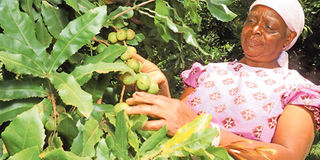Premium
Agronomist's notebook: Telephone farmers’ ideal enterprise

A farmer inspects her macadamia in a farm in Nyeri. Among the trees one can profitably grow in an agroforestry enterprise are Meru oak, eucalyptus, pine, avocado, moringa and macadamia. PHOTO | JOSEPH KANYI | NATION MEDIA GROUP
What you need to know:
- Different regions support different species of trees. Among the trees one can profitably grow are Meru oak, eucalyptus, pine, avocado, moringa and macadamia.
- The tree takes about three years to mature. They require spacing of 10 by 10 metres. One can grow 80 macadamia trees on a two-acre piece of land.
- A different scenario is when a farmer plants Hass avocados. It should be noted that demand for this fruit has risen exponentially in the past few years.
- Growing trees requires minimal field management practices. Little supervision is needed. A farmer can therefore plant trees many kilometres away from his home.
At a recent training forum, I joined a group of farmers who were discussing the purchase of two acres of land.
Some were of the opinion that with the unpredictable weather, high cost of inputs and lack of market for produce, farming is no longer viable.
What many Kenyans do not know is that among the many ways of utilising land with minimal costs, agroforestry stands out. If carried out properly, agroforestry has high returns. Agroforestry refers to growing crops and trees and rearing livestock on one farm.
I will concentrate on growing trees as one of the ways of utilising land. This kind of farming requires few inputs. It is also less vulnerable to the change of seasons compared to crop husbandry.
Different regions support different species of trees. Among the trees one can profitably grow are Meru oak, eucalyptus, pine, avocado, moringa and macadamia.
In Mt Kenya, for instance, farmers are harvesting nuts from macadamia trees. A kilogramme of the nuts is being sold at Sh200.
The tree takes about three years to mature. They require spacing of 10 by 10 metres. One can grow 80 macadamia trees on a two-acre piece of land.
On average, a tree produces 50 to 80 kilogrammes of nuts per season. That means a farmer with two acres can make about Sh80,000 per season. With minimal price fluctuations, a farmer can make good money as years progress.
A different scenario is when a farmer plants Hass avocados. It should be noted that demand for this fruit has risen exponentially in the past few years.
With spacing of seven by seven metres, a two-acre plot can have about 140 avocado trees. One tree can produce 500 to 600 fruits every year, with a fruit being sold for around Sh5.
CALAMITIES CAN STRIKE ANY TIME
A farmer with a two-acre piece can therefore make about Sh350,000 every year. These two tree species do well in vast ecological zones.
However, the farmer can opt for alternatives, depending on ecological conditions of his area and preferences. Unlike crop farming, there is always a ready market for fruits and timber.
Growing trees requires minimal field management practices. Little supervision is needed. A farmer can therefore plant trees many kilometres away from his home.
Tree growing is therefore ideal for telephone farmers. Some of the field management practices required when growing trees include pruning, thinning, weeding and controlling pests and diseases.
Agroforestry offers a sustainable, stable, aesthetic and resilient way of utilising agricultural land. It can also curb soil erosion and minimise the use of chemicals.
If practised in a large area, the continuous growth of trees can eventually lead to the development of a micro-catchment climate.
The accumulation of carbon (iv) oxide in the atmosphere can also decline. This can help reduce global warming. Different tree species provide different products such as timber, fuel and medicine. There is also bee keeping, which goes well with agroforestry.
Like the other forms of farming, however, profit is not always guaranteed as calamities can strike any moment. The farmer can incur a lot of expenses in the initial stages of this kind of farming. Transporting tree products and seedlings can also be costly.
One has to be ready to combat pests and diseases. Forest fires, particularly during the dry seasons, can also lead to losses.
Agroforestry is one of the most sustainable intensive farming systems. Farmers should unleash their potential through utilising their land properly.





